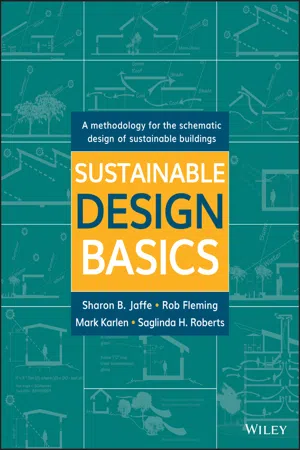
- English
- ePUB (mobile friendly)
- Available on iOS & Android
Sustainable Design Basics
About this book
An accessible, climate-diverse guide that transforms readers from sustainable design novices to whole-solution problem solvers.
Sustainable Design Basics is a student-friendly introduction to a holistic and integral view of sustainable design. Comprehensive in scope, this textbook presents basic technical information, sustainability strategies, and a practical, step-by-step approach for sustainable building projects. Clear and relatable chapters illustrate how to identify the factors that reduce energy use, solve specific sustainable design problems, develop holistic design solutions, and address the social and cultural aspects of sustainable design. Requiring no prior knowledge of the subject, the text's easy-to-follow methodology leads readers through the fundamental sustainable design principles for the built environment.
Sustainably-constructed and maintained buildings protect the health and improve the productivity of their occupants, as well as help to restore the global ecosystem. The authors, leading practitioners and educators in sustainable design, have created a resource that provides a solid introduction to broad level sustainability thinking that students can take forward into their professional practice. Topics include space planning for sustainable design, integrative and collaborative design, standards and rating systems, real-world strategies to conserve energy and resources through leveraging renewable natural resources and innovative construction techniques and their impact on our environment.
Usable and useful both in and beyond the classroom, this book:
- Covers building location strategies, building envelopes and structures, integration of passive and active systems, green materials, and project presentation
- Examines cultural factors, social equity, ecological systems, and aesthetics
- Provides diverse student exercises that vary by climate, geography, setting, perspective, and typology
- Features a companion website containing extensive instructor resources
Sustainable Design Basics is an important resource aimed at undergraduate architecture and interior design students, or first-year graduate students, as well as design professionals wishing to integrate sustainable design knowledge and techniques into their practice.
Frequently asked questions
- Essential is ideal for learners and professionals who enjoy exploring a wide range of subjects. Access the Essential Library with 800,000+ trusted titles and best-sellers across business, personal growth, and the humanities. Includes unlimited reading time and Standard Read Aloud voice.
- Complete: Perfect for advanced learners and researchers needing full, unrestricted access. Unlock 1.4M+ books across hundreds of subjects, including academic and specialized titles. The Complete Plan also includes advanced features like Premium Read Aloud and Research Assistant.
Please note we cannot support devices running on iOS 13 and Android 7 or earlier. Learn more about using the app.
Information
1
Why, How, Who, and What
WHY USE THIS BOOK
HOW TO USE THIS BOOK
WHO SHOULD USE THIS BOOK
WHAT ARE THE PARAMETERS OF THIS BOOK
ORGANIZATION
EXERCISES
COMPANION WEBSITE
- PowerPoint files with simple slides that review the materials addressed in the book
- Narrated videos that review and augment concepts presented in the text
- Simulation and validation assignments which require energy modeling software
2
Mindset
Table of contents
- Cover
- Table of Contents
- Acknowledgments
- About the Authors
- About the Companion Website
- 1 Why, How, Who, and What
- 2 Mindset
- 3 Step 1: Context
- 4 Step 2 Pre‐Planning
- 5 Step 3: Design
- 6 Step 3B: Passive Design
- 7 Step 3B: Passive Design, Daylighting
- 8 Step 3C: Building Envelope
- 9 Step 3D: Green Materials
- 10 Step 4: Design Resolution
- 11 Demonstration Project
- 12 Beyond the Basics
- 13 Design Resolution
- 14 Demonstration Project: Final Presentation
- 15 Exercises
- Appendix A: Demonstration Project Program, Climate, and Context Resources
- Appendix B: Forms and Matrices
- Appendix C: Energy Modeling Software
- Appendix D: Abbreviations and Acronyms
- Appendix E: Green Building Standards, Codes and Rating Systems
- Bibliography
- Index
- End User License Agreement